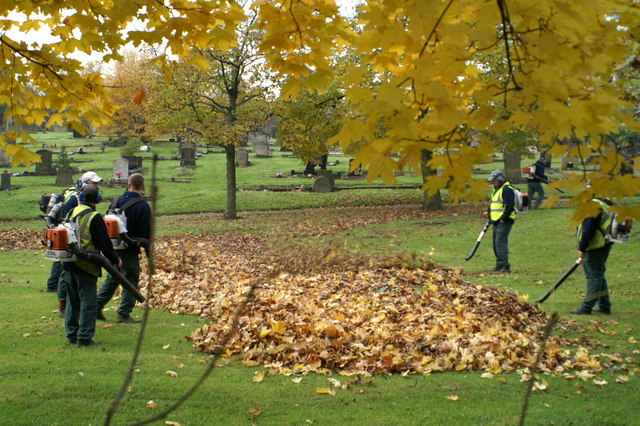How we manage leaves is one of the most financially wasteful and environmentally harmful landscape practices common to our area. The good news is that an ecological approach to leaf management can be embraced by fiscal conservatives and passionate environmentalists alike. So, what is a better way to manage leaves?
The answer is the ‘Love ‘em and Leave ‘em’ approach to leaf management.
As leaves turn different shades of red, orange, and gold, and fall from the trees, let’s manage them in ways that turn them from an expense into an asset.
The costs of leaf removal
Leaf removal is an expense for both private property owners and municipalities with the municipal costs passed along as a tax burden to residents. And much of that cost is incurred after someone hauled the leaves to the curb!

Homeowners too know the cost of leaf removal, whether it is spending fall weekends hauling them, or paying someone else to do it.
Additional, hidden costs of leaf removal include:
- Fossil fuel use of landscape equipment and trucks.
- Air, noise, and water pollution.
- Equipment costs including purchasing, repair, and replacement.
- Labor costs in time, money, and insurance.
- Costs of mulch needed to replace removed leaves in the spring.
The benefits of leaves
Leaves are referred to “leaf litter” once they fall on the ground. This is poor word selection because of the immense value that they provide. So groups like the Xerces Society are working to educate the public about their benefits.
- Food and shelter – In addition to many animals and organisms eating them, insects such as fireflies, lady bugs, and butterflies lay eggs on and overwinter in leaf litter. Birds scratch around in the leaves to find these hidden treats, while salamanders, toads and other animals hide in this ground layer and use it for insulation in the winter months.
- Moisture retention – Many animals are small enough to use the water that pools in leaf litter. In addition, leaves keep moisture in the soil by providing a barrier to evaporation.
- Soil improvements – As leaves break down, they provide important organic material for the soil. This allows for better soil structure, allows water to percolate into the soil, and reduces the need for fertilizer.
- Healthy plants – Trees and shrubs are healthier with more nutrients in the soil.
- Natural mulch – Leaves provide a natural layer of mulch, regulating temperature, reducing erosion, and improving plant health.

‘Love ‘em and Leave ‘em’
Some municipalities are already initiating leave the leaves strategies. Westchester County, New York has initiated an environmental and cost-saving initiative to leaf management called ‘Love ‘em and Leave ‘em’. We can follow their example and treat leaves like an asset.
By far the easiest way to do this is to leave them in place and skip leaf removal altogether. Garden beds, edges of properties, and grassy areas are fine with some leaf coverage. What falls in these areas will simply break down over time and become next year’s mulch.

Manage areas with very large amounts of leaves differently, because too many leaves will damage grass. Here, simply mulch leaves in place by mowing over them until they are small. Mow over them several times, or attach a mulching blade to your mower to increase efficiency. Purchase mulching blades to fit your mower, or if you have a lawn service, ask if that option is available. Finally, move mulched leaves into beds if you are still concerned about damage to grass. And consider converting some of this turf into beds to reduce this issue next year!
Try this practice at home to reduce the time and expense of fall leaf removal while improving the environment. Then convince your municipality to institute a “Love ‘em and leave ‘em” approach to leaf management. And as always, contact us if you need help!

Sign up to receive our free Landscaping Price Guide.
In addition to the pricing guide, you will receive a monthly newsletter with tips and trends in ecological and sustainable landscaping.

